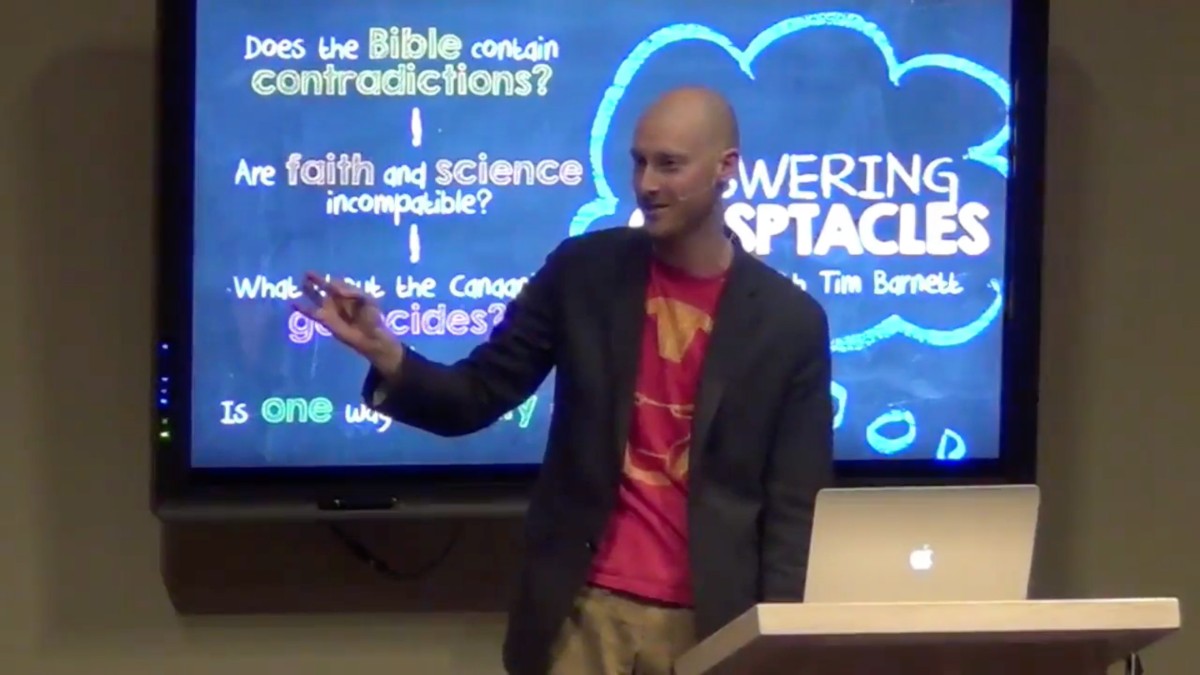Tim debunks the assertion that the Bible is filled with contradictions.
Transcript
How many of you have seen this graphic before? Has anyone seen this? There’s one of you. If you google “Bible contradictions” you will stumble upon this graphic. What you are looking at is every single chapter of the Bible. The white is the Old Testament, and then we get over here, that’s the grey. That’s the New Testament. Every rainbow you see starts one place at one verse and ends at another verse, and the claim is every single bow you see on this graphic is a contradiction. Okay? Is a contradiction.
So there’s contradictions within the Old Testament, there’s contradictions within the New Testament, and then there are contradictions that go from the Old Testament into the New Testament. That’s a lot of contradictions. In fact, they list them. There are about 440 on this one graphic. Does anyone feel uncomfortable? I hope so.
Alright, so this is the kind of thing that’s out there. It’s the kind of thing that’s out there. We need to be careful to define what we mean by a contradiction. The word gets thrown around by unbelievers when talking about the Bible all the time, but we need to distinguish between a genuine contradiction which cannot be resolved, it’s impossible to reconcile, and a mere difference which is possible to reconcile. Okay, so the difference between a contradiction and a difference: One can be reconciled, and one can’t be.
Now, to illustrate this, let me tell you about the Titanic. In 1912, The Titanic sank. Big boat, 800 feet long, and eyewitnesses who saw the boat sink had conflicting testimonies. Some eyewitnesses said the boat sank in one piece. Other eyewitnesses said it broke in two and then the two pieces sank. How you can get this wrong, I don’t know, but these are contradictory accounts that cannot be reconciled, okay? So that’s an example of a contradiction.
Let me tell you another story. Consider my wife winning the Publishers Clearing House sweepstakes. This is not a true story. When I get home from work, she explains what happened. She says, “Around noon the doorbell rang, and I went to the door, and there was a man holding a giant check for a million dollars.” That’s what she tells me. And then I hear her talking with her mom on the phone an hour later explaining what happened, okay? And this is what she says to her mother, “At 12:10 p.m. I was right in the middle of making lunch when the doorbell rang. I ran and got Allison because the doorbell woke her up from her nap. I wasn’t impressed. But when I answered the door, there was a man holding a giant check for a million dollars and another man recording the whole thing on live TV. At first I thought this was a big joke, but when I realized it was for real, I started crying with joy.”
Now, are those two accounts contradictory? I actually didn’t say anything contradictory in those accounts. One was just giving way more detail than the other. One gave more precise details than the other. And so this is the kind of thing we’re going to see in the gospels. Notice that many of the differences in these two stories are differences, but they’re not contradictory. Okay, it would have been an issue if my wife got off the phone with her mother and I said, “You stinkin’ liar,” right? “You lied!” No, she didn’t lie. “You contradicted yourself!” No.
So, many of these alleged contradictions that arise, arise because we apply an unfair standard or expectation to the Bible, okay? What can happen is we just assume that the biblical authors wrote just as we do today in the 21st century. And then we end up applying our 21st century standard to a, in the case of the New Testament, a first century document, and that would be a gross mistake.
In fact, listen, most claims of Bible contradictions stem from the reader misunderstanding the author’s intent, okay? If you didn’t put anything else in this lesson, this is how most contradictions, alleged contradictions come out. It’s the reader who misunderstands the author’s intent. Sometimes they misunderstand it. Sometimes they just misrepresent it, okay? That can happen too. So the error stems in the reader, not the author.

